Mercedes-Benz Vito
The Mercedes-Benz Vito is a light commercial van (M) produced by Mercedes-Benz. It is available as a standard panel van for cargo (called Vito), or with passenger accommodations substituted for part or all of the load area (called V-Class or Viano).
_%E2%80%93_Frontansicht%2C_29._Juni_2016%2C_D%C3%BCsseldorf.jpg) | |
| Overview | |
| Manufacturer | Daimler-Benz (1996–1998) DaimlerChrysler (1998–2007) Daimler AG (2007–present) |
| Also called |
|
| Production | 1996–present |
| Assembly | |
| Body and chassis | |
| Class | Light commercial vehicle (M) |
| Body style | Van Minibus |
| Powertrain | |
| Engine | 2.0 L OM654 I4 CDI Diesel 2.2 L OM651 I4 CDI Diesel 3.0 L OM642 V6 CDI Diesel |
| Transmission | 5-speed automatic 6-speed manual 7-speed automatic |
| Chronology | |
| Predecessor | Mercedes-Benz MB100 (for Vito) Mercedes-Benz R-Class (for V-Class) |
The V-Class/Viano is a large MPV. The first generation went on sale in 1996. The second generation was introduced in 2004, and the vehicle received the new Viano name. In 2010, the vehicle was facelifted with revised front and rear bumpers and lights. The interior was also improved with upgraded materials and new technology. The third generation was launched in 2014 and returned to being called V-Class.
The Viano is available in both rear- and four-wheel-drive configurations and comes in three lengths, two wheelbases and a choice of four petrol and diesel engines (as well as two specialist tuned models) coupled to either a six-speed manual or five-speed TouchShift automatic transmission.
First generation (W638; 1996–2003)
_%E2%80%93_Frontansicht%2C_12._August_2013%2C_Velbert.jpg)
_%E2%80%93_Heckansicht%2C_12._August_2013%2C_Velbert.jpg)
The first generation Mercedes-Benz Vito was produced between 1996 and 2003. It is powered either by a diesel engine with up to 120 bhp (89 kW; 122 PS) or a gasoline engine with up to 140 bhp (104 kW; 142 PS) and a front-wheel drive drivetrain. The range of gasoline engines consists of two old units from Mercedes (113 and 114) and a Volkswagen 2.8 VR6 engine, designated as the M104.900. When it comes to diesel engines, old 2.3 with and without turbo and also modern CDI 2.2 engines are available.
This body design was also sold as the V-Klasse in more luxurious and expensive version (V-Klasse was replaced with the Viano-name for the second generation of Vito). The Viano also included less van like features to the Vito such as only two seats in the front and a larger and more spacious seating capacity. At first many Vito drivers who wanted a spacious, small van opted for the Vito microbus which was extremely similar to the Viano, apart from its more van like and less luxurious features. The Viano was however a good, more car like option to the Vito microbus. It was designed by Michael Mauer from 1989 to 1991, when the final design was chosen and patented in February 1993.[1]
Second generation (W639; 2003–2014)
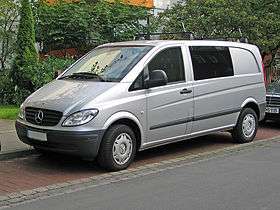 | |
| Overview | |
| Also called | Mercedes-Benz Viano Mercedes-Benz Valente (Australia) Mercedes-Benz V-Class (Japan) |
| Production | 2003–2014 (Spain) 2008–present (Mexico) 2010–2015 (China) |
| Assembly |
|
| Body and chassis | |
| Body style | 4-door van 4-door minibus |
| Layout | FR Layout F4 Layout |
| Powertrain | |
| Engine | 2.2 L OM646 980 L4 Turbo Diesel (China) 2.2 L OM646 DE22 LA R L4 Diesel 2.2 L OM651 DE22 L4 Diesel 3.0 L OM642 V6 Diesel 2.5 L M272 924 V6 (China) 3.0 L M272 939 V6 (China) 3.2 L M112 E32 V6 Petrol (2010–) 3.5 L M272 E35 V6 Petrol 3.7 L M112 E37 V6 Petrol 4.3 L Brabus V6 Petrol 6.0 L M119 Brabus V8 Twin-Turbo Petrol |
| Transmission | 6-speed Manual 5-speed TouchShift (Automatic) |
| Dimensions | |
| Wheelbase | 3,200 mm (126.0 in) (SWB) 3,430 mm (135.0 in) (LWB) |
| Length | 4,748–5,223 mm (186.9–205.6 in) |
| Width | 1,906 mm (75.0 in) |
| Height | 1,875 mm (73.8 in) |
| Curb weight | 2,040–2,135 kg (4,497–4,707 lb) |
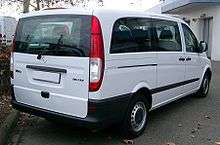
Six or seven seats come as standard in most markets. The Viano can be turned into an eight-seat people carrier by fitting two three-seater benches in the rear. All rear seats slide in 1-inch (2.5 cm) increments, recline and can be turned to face one other. They can also be folded down or removed completely to increase the load capacity. A rear folding table is standard in six- and seven-seat layouts.[2] The rear seats cannot be folded into the floor like on some rivals.
With all the seats removed the Viano Extra-Long can accommodate up to 4,610 litres (163 cu ft) of cargo[3] with a payload of 930 kg (2,050 lb).[4] It can tow a 2,500 kg (5,512 lb) braked trailer and a 750 kg (1,653 lb) unbraked trailer. An adjustable self-levelling rear suspension is included on higher specification models.[5]
Rear-wheel drive allows the Viano to have a smaller turning circle than front-wheel drive rivals; Compact and Long models have a turning circle of 11.8 m (39 ft) whereas the Extra-Long model turns in 12.5 m (41 ft).[6]
Japan passenger models were sold as the V-Class, as the V 350. Early models included V 350 Trend (RHD), V 350 Ambiente (RHD), V 350 Ambiente long (RHD).[7]
In 2012, Mercedes-Benz released the Valente model in Australia to sit beneath the Viano as the entry-level passenger van.
Initial release
Vito
The Vito was launched in China in April 2010. Engine choices consisted of the 2.1 litre OM646 turbo diesel four-cylinder, the 2.5 litre M272 diesel V6 and the 3 litre diesel V6 which also uses the M272 name. A 6 speed manual gearbox is standard for four cylinder diesel variants while V6 diesel variants are equipped to a 5 speed automatic gearbox. Trims levels are available known as the 2.1T Diesel Elite. 2.1T Diesel Service, 2.5L Elite, 2.5L Service, 3.0L Service and 3.0L Business. Pricing ranges from 316,000 yuan to 389,000 yuan (46,000 to 55,830 USD - March 2020 exchange rate).[8] [9] For actual car badging, the 2.1 litre Diesel models were known as the 115 CDI, the 119 for 2.5 litre V6 models and the 122 for 3 litre V6 models. The W639 Vito was then succeeded by the W447 in 2016 although most Vitos of the W639 variant are still in use for the Chinese market as of 2020 as ambulance vans in Beijing.
The second generation Mercedes-Benz Vito design that is more streamlined than its predecessor, powered by a new range of engines, and a rear-wheel drive (RWD) drivetrain.
The angle of the windshield and A-pillar is closer to horizontal; the dashboard is bigger and the bonnet (hood) smaller. The new Vito is available in three different lengths and four diesel engine versions: the 109 CDI, 111 CDI, 115 CDI (all powered by a 4-cylinder 2.2-litre engine) and the 120 CDI (featuring the 3.0-litre V6 unit). The model numerics relate to their engine power output: currently the 109 has 95 PS (70 kW; 94 hp), the 111 has 116 PS (85 kW; 114 hp), the 115 has 150 PS (110 kW; 148 hp), and the 120 has 204 PS (150 kW; 201 hp). Blue-efficiency technology is optional. The vehicles have a new 6-speed manual gearbox gear ratios designed for fuel economy. The second generation Vitos are Euro 3 compliant (additionally Euro 4 compliant as of November 2006) and exempt from the Low Emission Zone in London, which requires commercial vehicles (vans) to reach at least Euro 3 standard from October 2010.
Vito London Taxi
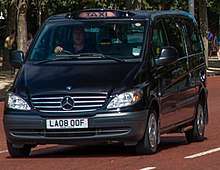
In August 2008, a variant of the Vito was approved by the Public Carriage Office for use as a licensed London 'black cab'.[10] The Vito taxicab includes electric sliding doors, electric steps and seating for six people. The Vito's rear-wheel steering enables it to meet the PCO's strict Conditions of Fitness requirements including a 25 ft (7.6 m) turning circle and wheelchair accessibility.[11] The vehicle, a variation of the 'Traveliner' model, is built by Penso in Coventry. The rear wheel steer system is licensed from one80, and it is distributed through Eco City Vehicles subsidiary KPM-UK Taxis.[12]
The new Taxi does not perform the famous U-turn in the same way as the TX and Metro models , instead it incorporates an electrically operated rear wheel system, activated by a button adjacent to the steering wheel. This turns the rear wheels in the opposite direction to the front wheels, thus allowing the Taxi to perform the same tight turning circle as the TX and Metro models. This system is only possible when the vehicle is traveling at less than 5 mph (8.0 km/h), and if the vehicle goes over this speed while the LSM is active, it is deactivated, and the wheels straighten up.
It is longer and wider than the TX models, but traveling through tight spaces is aided by the electric folding wing mirrors, which as of 2009 are standard.
Viano Marco Polo
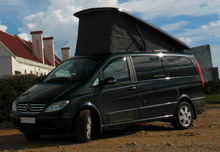
In some countries a camping derivative is available - known as the Marco Polo - equipped with a galley (including gas stove, sink, 40 L fridge, and storage), multi-function wardrobe and a sliding bench seat in the rear which can be turned into a large air-sprung bed. A pop-up roof is also standard (electric assist is optional) providing standing height inside. An additional bed can be fitted in the pop-up roof area to increase sleeping capacity to four individuals. Fresh water and waste water tanks are accessible from outside the vehicle, while the gas-cylinder bay is hidden inside an interior cupboard. An auxiliary battery is included under the front passenger seat. Up to six optional individual seats can be fitted for maximum MPV flexibility, but only four seats (including the two-seater bench mentioned above) can be used when in camping mode.
The Marco Polo was designed and created in partnership with Westfalia just like Volkswagen camper vans were until 1999. It was then Daimler AG bought a controlling stake in the conversion company meaning Volkswagen had to continue converting their commercial vehicles into camper vans alone.
Viano X-Clusive (2008–2010)
This edition was only available in European markets from 2008 to 2010 with either a petrol or diesel V6 engine.[13] It was available in either Brilliant Silver or Obsidian Black metallic paint, and featured a redesigned radiator grille, 18-inch alloy wheels, a chromed exhaust tailpipe, side skirts, and unique front and rear bumpers. The interior had pebble or anthracite coloured 'Twin' leather seats and a choice of grey or brown burr walnut wood accents.[14]
Engines
| Years | Model & Transmission | Engine | Power | Torque | Top Speed | 0-62 mph (0-100 km/h) | Economy | Emissions |
|---|---|---|---|---|---|---|---|---|
| Diesel | ||||||||
| 2004–2007 | Viano 2.0 CDI | 2.2 L, 4 in-L | 109 PS (80 kW) | 290 N⋅m (214 lb⋅ft) | 99 mph (159 km/h) | 17.6 s | 31.7 mpg‑imp (8.9 l/100 km) | 235 g/km |
| 2004–2007 | Viano 2.0 CDI TouchShift | 2.2 L, 4 in-L | 109 PS (80 kW) | 290 N⋅m (214 lb⋅ft) | 98 mph (158 km/h) | 17.3 s | 31.7 mpg‑imp (8.9 l/100 km) | 235 g/km |
| 2007–2010 | Viano 2.0 CDI | 2.2 L, 4 in-L | 116 PS (85 kW) | 290 N⋅m (214 lb⋅ft) | 99 mph (159 km/h) | 17.6 s | 34.9 mpg‑imp (8.1 l/100 km) | 215 g/km |
| 2007–2010 | Viano 2.0 CDI TouchShift | 2.2 L, 4 in-L | 116 PS (85 kW) | 290 N⋅m (214 lb⋅ft) | 98 mph (158 km/h) | 17.3 s | 32.8 mpg‑imp (8.6 l/100 km) | 229 g/km |
| 2004–2010 | Viano 2.2 CDI | 2.2 L, 4 in-L | 150 PS (110 kW) | 330 N⋅m (243 lb⋅ft) | 112 mph (180 km/h) | 14.9 s | 34.9 mpg‑imp (8.1 l/100 km) | 215 g/km |
| 2004–2010 | Viano 2.2 CDI TouchShift | 2.2 L, 4 in-L | 150 PS (110 kW) | 330 N⋅m (243 lb⋅ft) | 111 mph (179 km/h) | 13.0 s | 32.8 mpg‑imp (8.6 l/100 km) | 229 g/km |
| 2006–2010 | Viano 3.0 CDI TouchShift | 3.0 L, 6 in-V | 204 PS (150 kW) | 440 N⋅m (325 lb⋅ft) | 123 mph (198 km/h) | 9.2 s | 30.7 mpg‑imp (9.2 l/100 km) | 244 g/km |
| Petrol | ||||||||
| Viano 3.0 V6 TouchShift | 3.2 L, 6 in-V | 190 PS (140 kW) | ||||||
| Viano 3.2 V6 TouchShift | 3.2 L, 6 in-V | 218 PS (160 kW) | ||||||
| 2004–2007 | Viano 3.7 V6 TouchShift | 3.7 L, 6 in-V | 231 PS (170 kW) | 345 N⋅m (254 lb⋅ft) | 119 mph (192 km/h) | 11.0 s | 23.2 mpg‑imp (12.2 l/100 km) | 294 g/km |
| 2007- | Viano 3.5 V6 TouchShift | 3.5 L, 6 in-V | 258 PS (190 kW) | 340 N⋅m (251 lb⋅ft) | 127 mph (204 km/h) | 9.3 s | 23.7 mpg‑imp (11.9 l/100 km) | 284 g/km |
| n/a | Viano 4.4 Brabus TouchShift | 4.3 L, 6 in-V | 325 PS (239 kW) | 430 N⋅m (317 lb⋅ft) | 143 mph (230 km/h) | 7.2 s | n/a | n/a |
| n/a | Viano 6.1 Brabus TouchShift | 6.0 L, 8 in-V | 426 PS (313 kW) | 621 N⋅m (458 lb⋅ft) | 152 mph (245 km/h) | 6.2 s | n/a | n/a |
Safety
Two head-on airbags and (on higher trim levels) front side airbags are fitted as standard, with front window airbags available as an option. Electronic stability control (ESP), traction control system (ASR), anti-lock braking system (ABS), electronic brakeforce distribution (EBV) and brake assist (BAS) are all fitted as standard. If BAS is activated, the hazard lights flash to warn following motorists that the Viano driver is undertaking an emergency braking manoeuvre.[15]
Each seat is fitted with a three-point seatbelt with belt tensioner and force limiter and an adjustable head restraint.
The Viano underwent the Euro NCAP car safety tests in 2008 and achieved the following ratings:[16]
| Euro NCAP | Rating |
|---|---|
| Adult occupant: | |
| Child occupant: | |
| Pedestrian: |
The Australasian New Car Assessment Program (ANCAP) also tested the Viano and gave it a score of 32.66 points out of 37.[17] It is the only van in Australasia to achieve the maximum five-star rating.
| ANCAP | Rating |
|---|---|
| Safety: |
Environmental impact
EcoTest analysed the emissions from the EU4-compliant 2.0 CDI 116 PS (85 kW; 114 hp) and 2.2 CDI 150 PS (110 kW; 148 hp) manuals and the EU5-compliant 2.2 CDI 163 PS (120 kW; 161 hp) TouchShift; the results are below:
| 2006–2010 | 2.0 CDI Manual | 116 hp | Diesel | |
| 2004–2010 | 2.2 CDI Manual | 150 hp | Diesel |
Next Green Car - an expert environmental organisation that analyses official vehicle emissions data rated the Viano. These Green Ratings (from 0 (cleanest) to 100 (dirtiest)) are listed below:[19]
| 68 | 2006–2010 | 3.0 CDI TouchShift | 204 hp |
| 70 | 2004–2010 | 2.0 CDI TouchShift | 116 hp |
| 71 | 2004–2010 | 2.0 CDI Manual | 116 hp |
| 71 | 2004–2010 | 2.2 CDI Manual | 150 hp |
| 75 | 2007–2010 | 3.5 V6 TouchShift | 258 hp |
| 79 | 2004–2010 | 2.2 CDI TouchShift | 150 hp |
Reviews
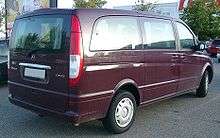
The Mercedes-Benz Viano has received mixed to positive reviews from the motoring press. The van-based design is seen as a blessing by some critics and a failing by others. As of July 2010 reviews for the facelifted Viano are not available.
- AA, The










'Image is everything in the world of business and it should come as no surprise that the Viano is the big cheese in the executive travel world.' - Autocar





'Still more van than MPV. Airport transport.' - Parker's





'Pros: Capable of carrying eight in comfort, massive and versatile interior, superb diesels'.
'Cons: Sheer size makes it difficult to manoeuvre, can't hide commercial vehicle origins.' - RAC










'With its rare combination of spacious seating and generous luggage capacity, the Viano is a paragon of practicality...' - What Car?





'For - Comes with a choice of two wheelbases and three body lengths, plus a variety of seating arrangements and plenty of space inside. The sliding rear side doors ease access.'
'Against - It's an expensive option, whose van roots show through in some areas. The engines are noisy and it's not easy to use the car's full versatility...' - Yahoo! Cars





"Most MPVs never make that much sense because when full of people there's nowhere for the lugagge to go. No such problem exists with the vast Viano."[26]
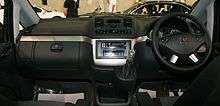
Motorsports
2006: The Viano was a support vehicle in the Dakar Rally for the Mercedes-Benz Service and Kwikpower team[27] 2009: The Viano claimed victory in the SUV category in the 19th Rallye Aicha des Gazelles with Irishwoman Jeanette James as pilot and Frenchwoman Anne-Marie Ortola as navigator.[27]
Production
On 16 April 2010 the assembly of the Viano W639 began at the Fujian Daimler Automotive plant in Fúzhōu, China. Forty per cent of the components and automotive parts of the Chinese model version are manufactured by local companies. The Chinese model was launched on the Chinese (Hong Kong, PRC and Republic), the South Korean and Southeast Asian market in April 2010.[28][29]
2010 facelift
Viano
_%E2%80%93_Frontansicht%2C_13._Juni_2011%2C_Wuppertal.jpg)
_Edition_125_CDI_3.0_BlueEFFICIENCY_van_(2015-07-24)_02.jpg)
Changes to the Viano range include standard BlueEFFICIENCY technology, new interior trim materials, new ambient lighting system with dimmable individual LED reading lamps and fibre optic units, optional rear seat entertainment system, redesigned cockpit, new suspension with front and rear axles revised and specially tuned to match each specific model and EU 5 emission standards compliance.[30]
The face lifted range included four and six-cylinder diesel and petrol engines rated at 100 kW (134 hp; 136 PS) to 190 kW (255 hp; 258 PS) (CDI 2.0, CDI 2.2, CDI 3.0, 3.5).[31][32]
A four-wheel drive (4MATIC) is optional on models with 4-cylinder diesel engines. In normal operation the system transfers driving power in a 35:65 split between the front and rear axles. The 4MATIC system does not have mechanical differential locks, but an electronic traction system (4ETS). If one or more wheels loses traction on a slippery surface, the system applies brief pulses of brake pressure to the spinning wheels thus increasing torque to wheels with good grip. Vehicles with four-wheel drive have a higher ride height, which increases approach, departure and breakover angles (20°/28°/19° respectively, versus 14°/22°/14° in conventional rear-wheel-drive models). The all-wheel drive adds 80 kg (176 lb) to the total weight of the vehicle.[33]
Vito
_%E2%80%93_Frontansicht%2C_3._Juli_2011%2C_Essen.jpg)
The facelifted version of the Vito began from September 2010, and features restyled front and rear lights, restyled front bumpers, and more-efficient diesel engines adapted from the Mercedes-Benz Sprinter range. The Vito's suspension, instrumentation, steering wheel, and overall quality of materials was also improved.[34]
Early models included Vito 110 CDI, Vito 113 CDI, Vito 116 CDI, Vito 122 CDI, Vito 126, with 3 body lengths (compact, long, extra-long).[35][36]
Vito E-CELL (2010–)

The E-Cell was unveiled in 2010 Post Expo,[37] powered by a 36 kWh lithium-ion battery located in the underfloor unit, electric motor rated 81 PS (60 kW; 80 hp) and 280 N⋅m (207 lb⋅ft) of torque.
In 2012 a seven-seater Vito E-Cell was unveiled at the 2012 Geneva Motor Show[38] with electric motor (60 kW (80 hp), 280 N⋅m (207 lb⋅ft)), power electronics, transformer and AC/DC charger under the bonnet; lithium-ion batteries under the passenger compartment floor.
The Vito E-Cell is the first electric vehicle mass-produced in Spain. It will be fabricated by Mercedes-Benz Spain, in the factory of Vitoria-Gasteiz. The first manufactured units (91 already) were presented on 7 February 2011. The goal is to produce 474 units by the end of the year. Most of them will be sold to foreign companies (mainly in Germany; Berlin and Stuttgart), though the Basque supermarket gamble Eroski has got four vans for distribution duties. Last year, the government made a plan in order to encourage this kind of cars. 590 million € will be funded, from which 7 have gone to the 'E-Cell' project. This project will also be supported by the Basque and German governments.
Mercedes-Benz has chosen its Spanish factory in Vitoria for fabricating exclusively this van, which will substitute the current models Vito and Viano (the commercial-transport and passenger-carrier versions, respectively). Mercedes-Benz expected 100 vehicles to be produced by the end of 2010 and a further 2,000 by the end of 2011.[39]
The Vito E-Cell utilizes a front-wheel drive setup to save installation space for a 36-kWh lithium-ion battery pack housed underneath the van's cargo area. The E-Cell's electric motor has 60 kW (80 hp) and 280 N⋅m (207 lb⋅ft) of torque. The electric van has a range of 81 mi (130 km) and a top speed of 50 mph (80 km/h). [40] The UK market was allocated 50 vehicles for the first year. All customers are to be vetted to ensure suitability and must return the van after four years to Mercedes.[41]
The Vito E-Cell is a long van, with a distance of 3.2 meters between the axes, so that there is enough space for the batteries. With this aim of saving space, only the front-drive version is offered, unlike in the previous model, so a long development was needed, although some suspension components of the AWD (all-wheel drive) version were used. The vehicle has a payload capacity of 900 kg (1,984 lb), and a permissible total weight of three tons (3.050 kg, exactly).
The car does not show external changes with the other versions (except for the decoration): the body has not been modified, both the double side door and the helpful back 'gate' remain as before. The place for the refueling has also been used for the recharging connection.
The Vito E-Cell has got a complete and modern equipment. Among the main novelties, this model has a special heater connected to the high voltage network and to the basic heating system, in order to ensure pleasant conditions even in the coldest months.
In terms of safety, the new Mercedes keeps the same level as the other Vito models. The vehicle has an internal combustion engine, so, if a collision occurs, the batteries are protected by a shock element. The active safety also makes that the high-technology voltage network turns off when the airbag control unit activates. The Vito E-Cell comes standard with the Electronic Stability Program (ESP) and dual airbags.
This van is driven by an electric battery. This battery is placed under the chassis (where the petrol tank and the prop-shaft are normally), while the engine, the transformer and the charger are located in the engine's (a block of four or six cylinders) usual position, under the hood.
The battery consists of a Lithium ion battery pack split into 16 modules with 192 cells in all, with high energy density and a rated voltage of 360 volts. They are supplied by the company Magna, and they have a maximum range of 130 kg (287 lb) (just as the engine), but this can be reduced by the weather conditions, the ground's topography or even the cargo volume. It is considered that a range between 90 km and 100 km could be more realistic. Either way, it is supposed to be enough for a workday in urban delivery. The batteries weigh 550 kg (1,213 lb); their life is unknown. Their total charge time is six hours through a high voltage system (380 or 400 volts); with a domestic 230 volt supply the total charge time is double, about 12 hours. The total battery capacity is 36 kWh, 32 kWh are available for the vehicle operation. Moreover, Mercedes-Benz offers the vehicle in the form of 'renting', in which the manufacturer takes charge of updating the batteries when necessary.
The electric engine is a permanent synchronous magnet drive with a constant power of 60 kW (80 hp; 82 PS) and a maximum power of 70 kW (94 hp; 95 PS). The top speed is limited to 80 km/h (50 mph), and it has a maximum torque of 280 N⋅m (207 lb⋅ft) instantly available, which lets the van have a similar dynamic performance to one equipped with a modern diesel engine.
Engines
| Model | Years | Type/code | Power, torque/rpm |
|---|---|---|---|
| Viano 3.0 | 2010- | 3,199 cc (195.2 cu in) V6 (M 112 E 32) | 190 PS (140 kW; 187 hp) at 5600, 270 N⋅m (199 lbf⋅ft) at 2750-4750 |
| Viano 3.5 | 2010- | 3,498 cc (213.5 cu in) V6 (M 272 KE 35) | 258 PS (190 kW; 254 hp) at 5900, 340 N⋅m (251 lbf⋅ft) at 2500-5000 |
| Vito 119 | 2010- | 3,199 cc (195.2 cu in) V6 (M 112 E 32) | 190 PS (140 kW; 187 hp) at 5600, 270 N⋅m (199 lbf⋅ft) at 2750-4750 |
| Vito 126 | 2010- | 3,498 cc (213.5 cu in) V6 (M 272 KE 35) | 258 PS (190 kW; 254 hp) at 5900, 340 N⋅m (251 lbf⋅ft) at 2500-4000 |
| Model | Years | Type/code | Power, torque/rpm |
|---|---|---|---|
| Viano 2.0 CDI | 2010- | 2,143 cc (130.8 cu in) I4 two-stage turbo (OM 651 DE 22 LA red.) | 136 PS (100 kW; 134 hp) at 3800, 310 N⋅m (229 lb⋅ft) at 1400-2600 |
| Viano 2.0 CDI BlueEFFICIENCY | 2010- | 2,143 cc (130.8 cu in) I4 two-stage turbo (OM 651 DE 22 LA red.) | 136 PS (100 kW; 134 hp) at 2800-3000, 360 N⋅m (266 lb⋅ft) at 1600-2600 |
| Viano 2.0 CDI 4MATIC | 2010- | 2,143 cc (130.8 cu in) I4 two-stage turbo (OM 651 DE 22 LA red.) | 136 PS (100 kW; 134 hp) at 3800, 310 N⋅m (229 lb⋅ft) at 1400-2600 |
| Viano 2.0 CDI BlueEFFICIENCY 4MATIC | 2010- | 2,143 cc (130.8 cu in) I4 two-stage turbo (OM 651 DE 22 LA red.) | 136 PS (100 kW; 134 hp) at 2800-3000, 360 N⋅m (266 lb⋅ft) at 1600-2600 |
| Viano 2.2 CDI | 2010- | 2,143 cc (130.8 cu in) I4 two-stage turbo (OM 651 DE 22 LA) | 163 PS (120 kW; 161 hp) at 3800, 360 N⋅m (266 lb⋅ft) at 1600-2400 |
| Viano 2.2 CDI BlueEFFICIENCY | 2010- | 2,143 cc (130.8 cu in) I4 two-stage turbo (OM 651 DE 22 LA) | 163 PS (120 kW; 161 hp) at 3800, 360 N⋅m (266 lb⋅ft) at 1400-2400 |
| Viano 2.2 CDI 4MATIC | 2010- | 2,143 cc (130.8 cu in) I4 two-stage turbo (OM 651 DE 22 LA) | 163 PS (120 kW; 161 hp) at 3800, 360 N⋅m (266 lb⋅ft) at 1600-2400 |
| Viano 2.2 CDI BlueEFFICIENCY 4MATIC | 2010- | 2,143 cc (130.8 cu in) I4 two-stage turbo (OM 651 DE 22 LA) | 163 PS (120 kW; 161 hp) at 3800, 360 N⋅m (266 lb⋅ft) at 1400-2400 |
| Viano 3.0 CDI | 2010- | 2,987 cc (182.3 cu in) V6 turbo (OM 642 DE 30 LA) | 224 PS (165 kW; 221 hp) at 3800, 440 N⋅m (325 lbf⋅ft) at 1800-2400 |
| Viano 3.0 CDI BlueEFFICIENCY | 2010- | 2,987 cc (182.3 cu in) V6 turbo (OM 642 DE 30 LA) | 224 PS (165 kW; 221 hp) at 3800, 510 N⋅m (376 lbf⋅ft) at 1600-2800 |
| Vito 110 CDI | 2010- | 2,143 cc (130.8 cu in) I4 two-stage turbo (OM 651 DE 22 LA red.) | 95 PS (70 kW; 94 hp) at 3800, 250 N⋅m (184 lbf⋅ft) at 1400-2400 |
| Vito 110 CDI BlueEFFICIENCY | 2010- | 2,143 cc (130.8 cu in) I4 two-stage turbo (OM 651 DE 22 LA red.) | 95 PS (70 kW; 94 hp) at 3800, 250 N⋅m (184 lbf⋅ft) at 1400-2400 |
| Vito 113 CDI | 2010- | 2,143 cc (130.8 cu in) I4 two-stage turbo (OM 651 DE 22 LA red.) | 136 PS (100 kW; 134 hp) at 3800, 310 N⋅m (229 lbf⋅ft) at 1400-2600 |
| Vito 113 CDI BlueEFFICIENCY | 2010- | 2,143 cc (130.8 cu in) I4 two-stage turbo (OM 651 DE 22 LA red.) | 136 PS (100 kW; 134 hp) at 3800, 310 N⋅m (229 lbf⋅ft) at 1400-2600 |
| Vito 116 CDI | 2010- | 2,143 cc (130.8 cu in) I4 two-stage turbo (OM 642 DE 30 LA) | 163 PS (120 kW; 161 hp) at 3800, 360 N⋅m (266 lbf⋅ft) at 1600-2400 |
| Vito 116 CDI BlueEFFICIENCY | 2010- | 2,143 cc (130.8 cu in) I4 two-stage turbo (OM 642 DE 30 LA) | 163 PS (120 kW; 161 hp) at 3800, 360 N⋅m (266 lbf⋅ft) at 1600-2400 |
| Vito 120 CDI | 2006- | 2,987 cc (182.3 cu in) V6 turbo (OM 642 DE 30 LA) | 224 PS (165 kW; 221 hp) at 3800, 440 N⋅m (325 lbf⋅ft) at 1400-2800 |
| Vito 122 CDI | 2010- | 2,987 cc (182.3 cu in) V6 turbo (OM 642 DE 30 LA) | 224 PS (165 kW; 221 hp) at 3800, 440 N⋅m (325 lbf⋅ft) at 1400-2800 |
| Vito 122 CDI BlueEFFICIENCY | 2010- | 2,987 cc (182.3 cu in) V6 turbo (OM 642 DE 30 LA) | 224 PS (165 kW; 221 hp) at 3800, 440 N⋅m (325 lbf⋅ft) at 1400-2800 |
| Vito 204 Sports | 2006- | 2,987 cc (182.3 cu in) V6 turbo (OM 642 DE 30 LA) | 224 PS (165 kW; 221 hp) at 3800, 440 N⋅m (325 lbf⋅ft) at 1400-2800 |
| Model | Years | Type/code | Power, torque |
|---|---|---|---|
| Vito E-CELL | 2010- | Electric motor () | continuous: 81 PS (60 kW; 80 hp), 280 N⋅m (207 lb⋅ft) maximum: 95 PS (70 kW; 94 hp) |
Beginning with September 2011, BlueEFFICIENCY models of Viano and Vito include a new generator management system converts part of the kinetic energy produced into electric energy, which is then stored in the battery.[44]
Transmissions
| Model | Years | Types |
|---|---|---|
| Viano 3.0 | 2010- | ? |
| Viano 3.5 | 2010- | five-speed automatic |
| Model | Years | Types |
|---|---|---|
| Viano 2.0 CDI | 2010- | ECO Gear six-speed manual, five-speed automatic |
| Viano 2.0 CDI BlueEFFICIENCY | 2010- | ECO Gear six-speed manual, five-speed automatic |
| Viano 2.0 CDI 4MATIC | 2010- | five-speed automatic |
| Viano 2.0 CDI BlueEFFICIENCY 4MATIC | 2010- | five-speed automatic |
| Viano 2.2 CDI | 2010- | ECO Gear six-speed manual, five-speed automatic |
| Viano 2.2 CDI BlueEFFICIENCY | 2010- | ECO Gear six-speed manual, five-speed automatic |
| Viano 2.2 CDI 4MATIC | 2010- | five-speed automatic |
| Viano 2.2 CDI BlueEFFICIENCY 4MATIC | 2010- | five-speed automatic |
| Viano 3.0 CDI | 2010- | five-speed automatic |
| Viano 3.0 CDI BlueEFFICIENCY | 2010- | five-speed automatic |
Performance
| Model | Years | top speed | acceleration (s) | fuel economy | emission (g/km) |
|---|---|---|---|---|---|
| Viano 2.0 CDI | 2010- | 108 mph (174 km/h) | 14.1 | 38.7 mpg‑imp (7.30 l/100 km) | 192 |
| Viano 2.0 CDI TouchShift | 2010- | 107 mph (172 km/h) | 13.1 | 34.5 mpg‑imp (8.2 l/100 km) | 216 |
| Viano 2.2 CDI | 2010- | 117 mph (188 km/h) | 12.1 | 38.7 mpg‑imp (7.30 l/100 km) | 192 |
| Viano 2.2 CDI TouchShift | 2010- | 113 mph (182 km/h) | 11.1 | 34.5 mpg‑imp (8.2 l/100 km) | 216 |
| Viano 3.0 CDI TouchShift | 2010- | 125 mph (201 km/h) | 9.1 | 32.8 mpg‑imp (8.6 l/100 km) | 226 |
All Viano and Vito engines conformed to Euro 5 emission standards.
Security
The Viano was tested by Thatcham's New Vehicle Security Ratings (NVSR) organisation and achieved the following ratings:[45]
| NVSR | Rating |
|---|---|
| Theft of car: | |
| Theft from car: |
Environmental impact
EcoTest analysed the emissions from the EU4-compliant 2.0 CDI 116 PS (85 kW; 114 hp) and 2.2 CDI 150 PS (110 kW; 148 hp) manuals and the EU5-compliant 2.2 CDI 163 PS (120 kW; 161 hp) TouchShift; the results are below:
| 2010 - on | 2.2 CDI TouchShift | 163 hp | Diesel |
Next Green Car - an expert environmental organisation that analyses official vehicle emissions data rated the Viano. These Green Ratings (from 0 (cleanest) to 100 (dirtiest)) are listed below:[19]
| 53 | 2010-on | 2.0 CDI Manual | 136 hp |
| 53 | 2010-on | 2.2 CDI Manual | 163 hp |
| 59 | 2010-on | 2.0 CDI TouchShift | 136 hp |
| 59 | 2010-on | 2.2 CDI TouchShift | 163 hp |
| 62 | 2010-on | 3.0 CDI TouchShift | 224 hp |
2013 update
During 2013 a number of special editions were launched; including the Grand Edition Viano launched at the Geneva Motor Show. Two special version for the Japanese markets were launched the V350 White Edition (50 units) and Black Edition (170 units) with additional equipment, large alloy wheels and leather interior.[46]
Two updated camper vans were launched at the 2013 Caravan Salon; the Fun and Marco Polo.[47]
Engines
| Model | Years | Type/code | Power, torque/rpm |
|---|---|---|---|
| Viano 3.0 | 2013- | 3,199 cc (195.2 cu in) V6 (M 112 E 32) | 190 PS (140 kW; 187 hp) at 5600, 270 N⋅m (199 lbf⋅ft) at 2750-4750 |
| Viano 3.5 | 2013- | 3,498 cc (213.5 cu in) V6 (M 272 KE 35) | 258 PS (190 kW; 254 hp) at 5900, 340 N⋅m (251 lbf⋅ft) at 2500-5000 |
| Model | Years | Type/code | Power, torque/rpm |
|---|---|---|---|
| Viano 2.2 CDI | 2013- | 2,143 cc (130.8 cu in) I4 two-stage turbo (OM 651 DE 22 LA) | 163 PS (120 kW; 161 hp) at 3800, 360 N⋅m (266 lbf⋅ft) at 1600-2400 |
| Viano 3.0 CDI | 2013- | 2,143 cc (130.8 cu in) V6 turbo (OM 642 DE 30 LA) | 224 PS (165 kW; 221 hp) at 3800, 440 N⋅m (325 lbf⋅ft) at 1400-2800 |
UK models included only 2.2 CDI (long/extra long), 3.0 CDI (long/extra long).
Transmissions
| Model | Years | Types |
|---|---|---|
| Viano 3.0 | 2013- | ? |
| Viano 3.5 | 2013- | ? |
| Model | Years | Types |
|---|---|---|
| Viano 2.2 CDI | 2013- | 6-speed manual, 5-speed automatic |
| Viano 3.0 CDI | 2013- | 6-speed manual, 5-speed automatic |
Production
As of 14 November 2013, Daimler's van joint venture Fujian Benz Automotive Co. (FBAC) has secured an order by the Dalian Wanda Group comprising 85 Mercedes-Benz Viano 3.0L vans.[48]
Third generation (W447; 2014–present)
_%E2%80%93_Frontansicht%2C_18._Oktober_2015%2C_Ratingen.jpg) | |
| Overview | |
| Also called | Mercedes-Benz V-Class Mercedes-Benz Marco Polo (camper models) Mercedes-Benz Metris (North American models) Mercedes-Benz EQV (electric models) Mercedes-Benz Valente |
| Production | 2014–present |
| Assembly |
|
| Body and chassis | |
| Body style | 4-door van 4-door minibus |
| Layout | FF Layout FR Layout F4 Layout |
| Powertrain | |
| Engine | 1.6L OM 622 DE 16 LA I4 Turbo Diesel 1.7L OM 622 DE 17 LA I4 Turbo Diesel 2.0L OM 654 I4 two-stage turbo Diesel 2.2L OM 651 DE 22 LA red. I4 two-stage turbo Diesel 2.0L M274 I4 Petrol (China, USA&Canada) |
| Electric motor | 2x asynchronous electric motors (Mercedes-Benz EQV) Permanent synchronous magnet electric motor (eVito Tourer) |
| Transmission | ECO Gear 6-speed manual 7G-TRONIC PLUS 7-speed Automatic 9-speed 9G-Tronic automatic Single speed with fixed ratio (Mercedes-Benz EQV / eVito Tourer) |
| Dimensions | |
| Wheelbase | 3,200 mm (126.0 in) (SWB) 3,430 mm (135.0 in) (LWB) |
| Length | 5,140 mm (202.4 in) (SWB) 5,370 mm (211.4 in) (LWB) |
| Width | 1,928 mm (75.9 in) (body only) 2,057 mm (81.0 in) (mirrors folded) 2,249 mm (88.5 in) (mirrors unfolded) |
| Height | 1,901–1,908 mm (74.8–75.1 in) |
_%E2%80%93_Heckansicht%2C_18._Oktober_2015%2C_Ratingen.jpg)
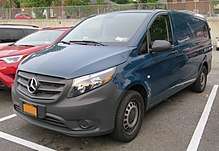
The third generation V-Class was launched in 2014 as a full size MPV to replace the Viano and R-Class.[49] However, it was marketed as a successor to the Mercedes-Benz Viano.[50] Sales commenced in Germany in May 2014, with European sales following in June.[51] The car is sold in the United States and Canada as the Mercedes-Benz Metris since 2015 as a 2016 model year. At the time of its introduction it was the least expensive starting price for a new Mercedes-Benz model in the United States according to Car and Driver magazine.[52]
The V-Class was a long-wheelbase model initially, with compact and extra-long variants due at a later date.[53][54] A special launch model based on the V 250 BlueTEC is called Edition 1, and is fitted with a range of additional equipment including leather interior, Burmeister sound system and large alloy wheels and Agility Control suspension system.
Vito (2014–present)
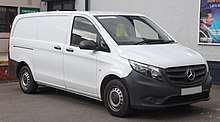
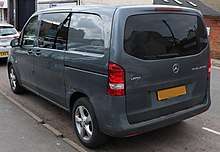
Changes to Vito included standard Attention Assist and Crosswind Assist, optional Intelligent Light System (LED indicators, LED daytime running lamps, LED low-beam headlamps, main beam with cornering light function).
The vehicle was unveiled in 2014 International Commercial Vehicles show.[55]
Production
Production of V-Class in Vitoria, Spain plant began in March 2014, followed by Mercedes-Benz Vito in autumn 2014.[56] Also, it started production in Argentina[57] and production at the Fujian Daimler plant in Fúzhōu, China started in March 2016.
.jpg)
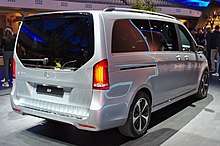
Engines[58][59]
| Model | Years | Type/code | Power, torque/rpm |
|---|---|---|---|
| V 200 CDI | 2014- | 2,143 cc (130.8 cu in) I4 two-stage turbo (OM 651 DE 22 LA red.) | 136 PS (100 kW; 134 hp) at 3800, 330 N⋅m (243 lbf⋅ft) at 1200-2400 |
| V 220 CDI | 2014- | 2,143 cc (130.8 cu in) I4 two-stage turbo (OM 651 DE 22 LA) | 163 PS (120 kW; 161 hp) at 3800, 380 N⋅m (280 lbf⋅ft) at 1400-2400 |
| V 250 BlueTEC | 2014- | 2,143 cc (130.8 cu in) I4 two-stage turbo (OM 651 DE 22 LA) | 190 PS (140 kW; 187 hp) at 3800, 440 N⋅m (325 lbf⋅ft) at 1400-2400 overboost: 200 PS (147 kW; 197 hp) at 3800, 480 N⋅m (354 lbf⋅ft) at 1400-2400 |
| Vito 109 CDI | 2014- | 1,598 cc (97.5 cu in) I4 turbo (OM 622 DE 16 LA) | 88 PS (65 kW; 87 hp) at 3800, 230 N⋅m (170 lbf⋅ft) at 1500-2000 |
| Vito 110 CDI | 2020- | 1,698 cc (103.6 cu in) I4 turbo (OM 622 DE 17 LA) | 114 PS (84 kW; 112 hp) at 3800, 270 N⋅m (199 lbf⋅ft) at 1500-2000 |
| Vito 111 CDI | 2014- | 1,598 cc (97.5 cu in) I4 turbo (OM 622 DE 16 LA) | 114 PS (84 kW; 112 hp) at 3800, 270 N⋅m (199 lbf⋅ft) at 1500-2500 |
| Vito 114 CDI | 2014-2020 | 2,143 cc (130.8 cu in) I4 two-stage turbo (OM 651 DE 22 LA red.) | 136 PS (100 kW; 134 hp) at 3800, 330 N⋅m (243 lbf⋅ft) at 1200-2400 |
| Vito 114 CDI | 2020- | 1,698 cc (103.6 cu in) I4 turbo (OM 622 DE 17 LA) | 136 PS (100 kW; 134 hp) at 3800, 330 N⋅m (243 lbf⋅ft) at 1200-2400 |
| Vito 116 CDI | 2014-2020 | 2,143 cc (130.8 cu in) I4 two-stage turbo (OM 651 DE 22 LA) | 163 PS (120 kW; 161 hp) at 3800, 380 N⋅m (280 lbf⋅ft) at 1400-2400 |
| Vito 116 CDI | 2020- | 1,950 cc (119 cu in) I4 two-stage turbo (OM 651 DE 22 LA) | 163 PS (120 kW; 161 hp) at 3800, 380 N⋅m (280 lbf⋅ft) at 1400-2400 |
| Vito 119 BlueTEC | 2014- | 2,143 cc (130.8 cu in) I4 two-stage turbo (OM 651 DE 22 LA) | 190 PS (140 kW; 187 hp) at 3800, 440 N⋅m (325 lbf⋅ft) at 1400-2400 |
| Vito 119 CDI BlueTEC | 2020- | 1,950 cc (119 cu in) I4 two-stage turbo (OM 651 DE 22 LA) | 190 PS (140 kW; 187 hp) at 3800, 440 N⋅m (325 lbf⋅ft) at 1400-2400 |
| Vito 124 CDI | 2020- | 1,950 cc (119 cu in) I4 two-stage turbo (OM 654q) | 239 PS (176 kW; 236 hp) at 3800, 500 N⋅m (369 lbf⋅ft) at 1400-2400 |
| Model | Years | Type/code | Power, torque/rpm |
|---|---|---|---|
| EQV | 2020- | Permanent synchronous magnet electric motor | 204 PS (150 kW; 201 hp), 362 N⋅m (267 lbf⋅ft) |
| eVito Tourer | 2021- | Permanent synchronous magnet electric motor | 204 PS (150 kW; 201 hp), 362 N⋅m (267 lbf⋅ft) |
BlueEFFICIENCY package is standard on all versions of V-Class featuring the 7G-TRONIC PLUS automatic transmission and is optionally available for all variants with 6-speed manual transmission.
Blue Efficiency package is available for Vito with OM 651 engine and rear-wheel drive, and standard for all Vito models with automatic transmission and a car registration.
Overboost is available for vehicles with 7G-TRONIC PLUS transmission and AGILITY SELECT, with transmission mode set to "Comfort" (C), "Sport" (S), or "Manual" (M).
Transmissions
| Model | Years | Types |
|---|---|---|
| V 200 CDI | 2014- | ECO Gear 6-speed manual, 7-speed automatic (7G-TRONIC PLUS with DIRECT SELECT lever and DIRECT SELECT shift paddles) |
| V 220 CDI | 2014- | ECO Gear 6-speed manual, 7-speed automatic (7G-TRONIC PLUS with DIRECT SELECT lever and DIRECT SELECT shift paddles) |
| V 250 BlueTEC | 2014- | 7-speed automatic (7G-TRONIC PLUS with DIRECT SELECT lever and DIRECT SELECT shift paddles) |
| Vito 109 CDI | 2014- | ECO Gear 6-speed manual |
| Vito 110 CDI | 2020- | ECO Gear 6-speed manual |
| Vito 111 CDI | 2014- | ECO Gear 6-speed manual |
| Vito 114 CDI | 2014-2020 | ECO Gear 6-speed manual, 7-speed automatic (7G-TRONIC PLUS) |
| Vito 114 CDI | 2020- | ECO Gear 6-speed manual, 9-speed 9G-Tronic automatic |
| Vito 116 CDI | 2014-2020 | ECO Gear 6-speed manual, 7-speed automatic (7G-TRONIC PLUS) |
| Vito 116 CDI | 2020- | ECO Gear 6-speed manual, 9-speed automatic (9G-Tronic) |
| Vito 119 BlueTEC | 2014- | 7-speed automatic (7G-TRONIC PLUS) |
| Vito 119 CDI | 2020- | 9-speed automatic (9G-Tronic) |
| Vito 124 CDI | 2020- | 9-speed automatic (9G-Tronic) |
| Model | Years | Types |
|---|---|---|
| EQV | 2020- | Single speed with fixed ratio |
| eVito Tourer | 2021- | Single speed with fixed ratio |
V-Class with 7G-TRONIC PLUS transmission includes optional AGILITY SELECT system with 4 transmission modes ("ECO" (E), "Comfort" (C), "Sport" (S) and "Manual" (M)).
References
- "Mercedes-Benz Vito" Archived 2 February 2017 at the Wayback Machine. Press Porsche. Retrieved 2 June 2014.
- "Mercedes-Benz UK - Overview - Design". .mercedes-benz.co.uk. Archived from the original on 24 July 2010. Retrieved 4 July 2010.
- "Mercedes-Benz UK - Overview - Design". .mercedes-benz.co.uk. Archived from the original on 23 June 2010. Retrieved 4 July 2010.
- "Mercedes-Benz UK - Viano - Technical data". .mercedes-benz.co.uk. Archived from the original on 19 June 2010. Retrieved 4 July 2010.
- "Mercedes-Benz UK - Lines and equipment - Standard equipment". .mercedes-benz.co.uk. Archived from the original on 14 May 2010. Retrieved 4 July 2010.
- "Mercedes-Benz Viano MPV 3.0 CDI Ambiente SWB 5dr - Car Comparison - What Car?". Whatcar.com. Archived from the original on 27 July 2011. Retrieved 26 September 2010.
- メルセデス・ベンツ新型V クラスを発売
- "2010 Mercedes Benz Vito 2.1 litre diesel amd 2.5 litre V6 diesel specs (Chinese market)".
- "2013 Mercedes Benz Vito 3 litre V6 diesel specs (Chinese market)".
- "Public Carriage Office notice at Transport for London" (PDF). Archived from the original (PDF) on 14 July 2014. Retrieved 8 July 2014.
- Hail, the new London cab, London Evening Standard, 26 June 2008 Archived 19 August 2008 at the Wayback Machine
- Mercedes-Benz to launch eco-friendly London black cab, The Daily Telegraph, 17 June 2008
- "Mercedes-Benz UK - Viano - Viano X-CLUSIVE". .mercedes-benz.co.uk. Archived from the original on 1 April 2010. Retrieved 4 July 2010.
- "Mercedes-Benz UK - Viano - Viano X-CLUSIVE". .mercedes-benz.co.uk. Archived from the original on 23 June 2010. Retrieved 4 July 2010.
- "Mercedes-Benz UK - Overview - Safety". .mercedes-benz.co.uk. Archived from the original on 6 January 2010. Retrieved 4 July 2010.
- "Mercedes Benz Viano | Euro NCAP - For safer cars crash test safety rating". Euro NCAP. Retrieved 4 July 2010.
- "Mercedes-Benz safety | Viano crash test". ANCAP. Archived from the original on 6 March 2012. Retrieved 14 August 2012.
- "EcoTest". Ecotest.eu. Retrieved 1 February 2011.
- "MERCEDES-BENZ Viano CO2 Emissions – MERCEDES-BENZ Green Ratings at Next Green Car". Whatgreencar.com. 3 December 2009. Retrieved 20 July 2012.
- "Car Reviews: Mercedes-Benz Viano 3.0 CDI X-CLUSIVE - Long". The AA. Retrieved 4 July 2010.
- "Prices and Specs Editions". Autocar. Archived from the original on 1 December 2008. Retrieved 4 July 2010.
- "New Mercedes-Benz Viano Car Review - Parker's". Parkers.co.uk. Retrieved 4 July 2010.
- "Mercedes-Benz Viano Review - Car Reviews". RAC. Archived from the original on 23 July 2011. Retrieved 4 July 2010.
- "Mercedes-Benz Viano MPV - Readers Reviews - New Car Review - What Car?". Whatcar.com. 23 May 2005. Retrieved 4 July 2010.
- "Mercedes Viano Range : VIANO IN THE DARK? - Yahoo!! Cars". Yahoo!. Archived from the original on 16 February 2007. Retrieved 4 July 2010.
- "Review of the new Mercedes-Benz Viano Range". Buyacar.co.uk. 6 March 2006. Retrieved 14 August 2012.
- "Mercedes-Benz Viano 4MATIC class winner in women's rallye | Daimler Global Media Site > Mercedes-Benz Vans > Viano". Media.daimler.com. 8 April 2009. Archived from the original on 8 July 2011. Retrieved 4 July 2010.
- "Erstes Kundenfahrzeug bei Fujian Daimler Automotive produziert" (in German). Daimler AG. 16 April 2010. Retrieved 17 August 2010.
- 福建戴姆勒汽车工业有限公司 (in Chinese and English). Fujian Daimler Automotive. Archived from the original on 9 February 2014. Retrieved 17 August 2010.
- "New Mercedes-Benz Viano Van Offers Comfort and Efficiency". eMercedesBenz. Retrieved 4 July 2010.
- "Comfort, Sustainability, Design, Driving Pleasure: The new generation of Mercedes-Benz Viano". Archived from the original on 6 December 2013. Retrieved 4 June 2014.
- "Engine and drive system: clean, extremely economical and offering top-notch performance". Archived from the original on 6 December 2013. Retrieved 4 June 2014.
- "Mercedes-Benz Viano 4MATIC: traction, comfort and safety in perfection". media.daimler.com. Archived from the original on 26 March 2012. Retrieved 6 August 2011.
- "Mercedes-Benz Vito New-Generation Sets New Benchmarks in Vans Segment". Mercedes-Benz. 2 July 2010. Retrieved 17 August 2010.
- "Summary: The new Mercedes-Benz Vito". Archived from the original on 21 August 2014. Retrieved 19 August 2014.
- "Exterior and body: new highlights underscore the Vito's robust appearance". Archived from the original on 21 August 2014. Retrieved 20 August 2014.
- "Mercedes-Benz showcases the Vito E-CELL at the Post Expo in Stuttgart". Archived from the original on 21 August 2014. Retrieved 20 August 2014.
- "Mercedes-Benz at the 2012 Geneva Motor Show: Two world premieres and three European premieres in Geneva - Two world premieres and three European premieres in Geneva: Dynamism and efficiency". Archived from the original on 13 December 2013. Retrieved 13 December 2013.
- Abuelsamid, Sam (30 July 2010). "Mercedes-Benz introduces new Vito E-Cell van – Autoblog Green". Green.autoblog.com. Retrieved 17 August 2010.
- Eric Loveday (4 May 2011). "Europcar to offer Mercedes-Benz Vito E-Cell electric van rentals". AutoblogGreen. Retrieved 10 June 2011.
- Van Locator (1 July 2011). "Mercedes-Benz Vito E-Cell Hits the UK". Focus Publishing. Retrieved 10 July 2011.
- "Engine and drive system: unmatched economy and environmental friendliness". Archived from the original on 20 August 2014. Retrieved 20 August 2014.
- "Engine and drive system: clean, extremely economical and offering top-notch performance". Archived from the original on 21 August 2014. Retrieved 20 August 2014.
- "Mercedes-Benz Vito and Viano with enhanced BlueEFFICIENCY package". Archived from the original on 21 August 2014. Retrieved 20 August 2014.
- "New Vehicle Security Ratings". Thatcham.org. Archived from the original on 2 August 2011. Retrieved 14 August 2012.
- Vクラス特別仕様車2モデルを限定発売
- "Mercedes-Benz at the Caravan Salon 2013 - Reaching for the stars: Mercedes-Benz Commercial Vehicles with a broad portfolio at the Caravan Salon 2013". Archived from the original on 21 February 2014. Retrieved 4 June 2014.
- "Major Chinese order with an element of glamor: Dalian Wanda Group orders 85 Mercedes-Benz Viano vans". Archived from the original on 21 August 2014. Retrieved 20 August 2014.
- 2014 Mercedes-Benz V-Class interior officially revealed
- "Mercedes-Benz TecDay : The new V-Class - The Mercedes among Full Size MPVs". Archived from the original on 6 December 2013. Retrieved 4 June 2014.
- "The model range: Versatile and individual for the most widely ranging requirements". Archived from the original on 19 February 2014. Retrieved 4 June 2014.
- "Mercedes-Benz Metris - Car and Driver". caranddriver.com. Retrieved 8 June 2016.
- "The new V-Class: The Mercedes among MPVs". Archived from the original on 19 February 2014. Retrieved 4 June 2014.
- Mercedes debuts new V-Class van
- Mercedes-Benz Vans at the 2014 International Commercial Vehicles show (IAA): Public premiere for the Vito, flanked by the Sprinter and Citan – Mercedes-Benz Vans at the 2014 International Commercial Vehicles show (IAA)
- Europcar adds 175 new Mercedes-Benz V-Class MPVs to its rental car fleet Archived 21 August 2014 at the Wayback Machine
- http://autoblog.com.ar/2012/10/05/mercedes-benz-fabricara-la-nueva-vito-en-la-argentina/
- "Drive system - Efficient driving pleasure: six-cylinder power with four-cylinder fuel consumption". Archived from the original on 21 August 2014. Retrieved 20 August 2014.
- "One for all: choice of front, rear or all-wheel drive". Archived from the original on 21 August 2014. Retrieved 20 August 2014.

